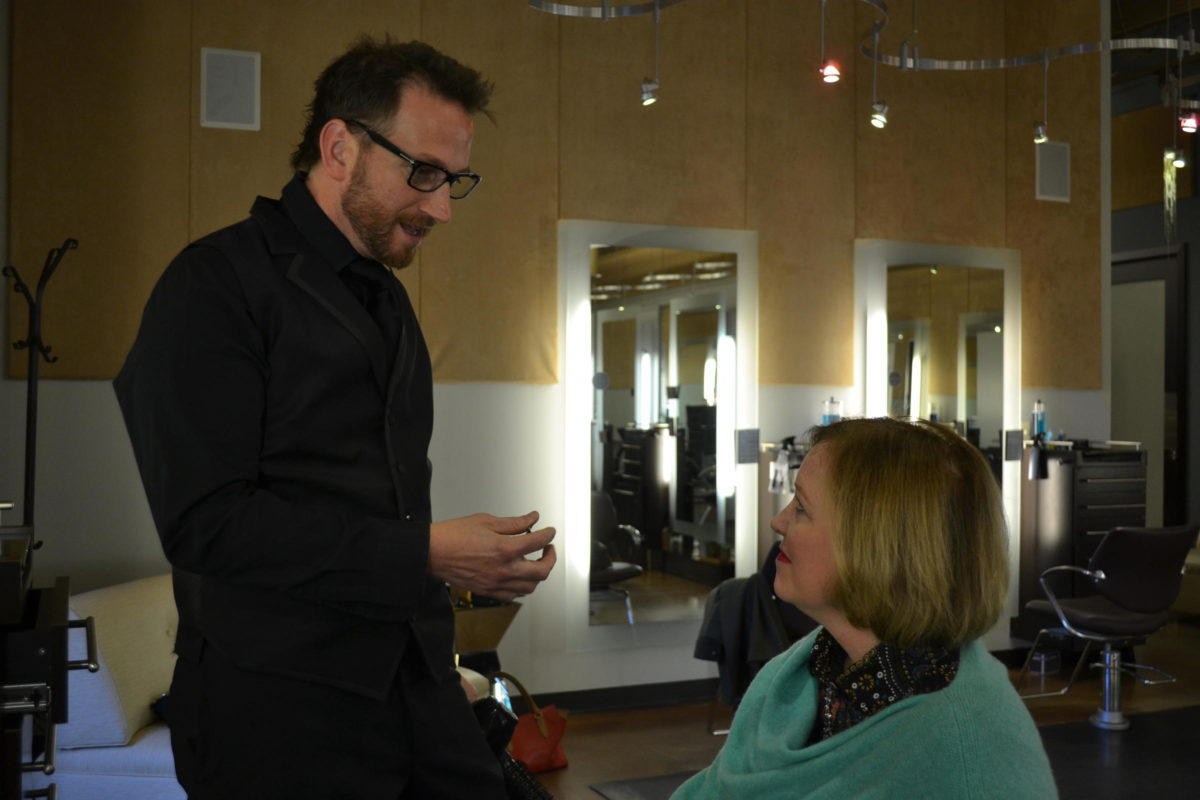Atlanta Hairdresser Ramps Up Knowledge To Help Cancer Patients

Katja Ridderbusch
It’s a normal day for Harry Wood, a hairdresser at Van Michael Salon in Buckhead, as he casually discusses his client’s styling routine.
Nothing was normal for Susan Webster 13 years ago, when she sat in the same salon chair and told Wood, her longtime hairdresser and friend, the sad news. She had just been diagnosed with Stage 2 breast cancer and was about to lose her hair. The two immediately went together to pick out a wig.
A few weeks later, as she stood in front of her bathroom mirror one morning, Webster held a clump of hair in her hands.
“Even though they warn you, you are somehow not prepared,” she says as she thinks back to that moment. “It is a little bit shocking when it happens.”
At the time, Webster was 45 and the mother of two young boys. She called her hairdresser. Wood came over to her house after work, shaved her head and placed the wig on her scalp.
“I was ready to get on with it,” Webster says. “I didn’t want to drag it out any longer, and it turned out to be the right way for me.”
Webster was fortunate, given the situation. Her hairdresser happened to be a friend – someone to help her with a dose of normalcy in a life deeply disrupted by illness.
However, this type of service should not be an exception, but the norm in his industry, Wood says.
“Because for most hairdressers, it’s not the question of if you come across somebody who has cancer, but a question of when,” he says.
Wood has been a stylist in Atlanta for 25 years. He’s also the author of several textbooks on hairdresser education. His latest, “Oncology Basics,” deals with hair loss and hair regrowth after chemotherapy.
“The goal is to make it a global standard for the hairdressing profession around the world, knowing how to take care of people with cancer,” he says.
There’s certainly a demand for the services that Wood advocates. According to the World Health Organization, the number of cancer cases is expected to rise by 70 percent over the next two decades. Patients suffering from hair loss as a side effect of cancer treatment create a growing market – not just for hospital wig clinics, but also for regular hair salons and beauty spas.
Adapting to this clientele could mean providing a private room for clients who are in treatment, or learning to properly wash and style a wig, Wood says.
Add to that some basic knowledge about the side effects of chemotherapy – that, for example, it’s quite painful when the hair starts falling out and the scalp stings and burns.
Wood says that as hairdressers, “we need to know what products to use when people are going through chemo and radiation, and their skin and scalp are super sensitive.”
Once chemotherapy is over, there’s another challenge.
“When the hair starts to grow back, it is much coarser and curlier,” he says. “It changes the texture. It’s chemo hair. You have to be gentle with it.”
Webster, whose hair is naturally straight and sandy blonde, has vivid memories of those days.
“Your hair almost looks like a little tennis ball,” she says with a dry laugh.
Quite often, it comes back in a different color too. Webster’s new hair was white.
“For some patients, it can also come back in dark patches,” Wood says.
For most patients however, the change is temporary. Like Webster, they will eventually go back to their old hair color and texture.
Body image issues are a typical psychological side effect of cancer treatment, says Dr. Wendy Baer, a clinical psychiatrist at Emory University’s Winship Cancer Institute. But there are medical concerns that hairdressers must keep in mind when working with a sick client.
“People going through cancer treatment often have infection risks,” Baer says. “Sometimes their white blood cell count is low. Sometimes they have a bleeding risk. You have to know where people are during therapy.”
Baer says if the beauty industry raises the bar by adapting to the needs of cancer patients, there’s an opportunity to bring in more clients.
That included clients like Webster. She didn’t want to spend any more time than absolutely necessary in the hospital, even a hospital hair salon.
“The sound of it, the smell of it, everything about being in that environment was not a preference for me, because of the clinical nature,” she says. “To be in a salon where I was comfortable and had happy memories felt a lot better than being in a doctor’s setting.”
Today, 13 years later, Webster is glad she kept her beauty routine during her illness. And she’s grateful her hairdresser was with her every step of the way, from shaving her head and washing the wig to cutting and coloring her freshly grown hair.
“Anything that can make you feel more normal and more your old self is a great thing,” Webster says.
Katja Ridderbusch is an Atlanta-based independent reporter and producer for German national public radio.
CORRECTION: An earlier version of this story misstated Dr. Wendy Baer’s title. Baer is a clinical psychiatrist at Emory University’s Winship Cancer Institute
9(MDAxODM0MDY4MDEyMTY4NDA3MzI3YjkzMw004))






